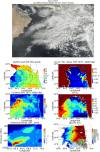Unique roll clouds along the flow path of the Indian summer monsoon low-level jet over the Arabian sea
- PMID: 40223036
- PMCID: PMC11994763
- DOI: 10.1038/s41598-025-97849-9
Unique roll clouds along the flow path of the Indian summer monsoon low-level jet over the Arabian sea
Abstract
Unique boundary layer roll clouds in the form of parallel straight lines are formed along the flow path of the Arabian Sea branch (ASB) of the Indian summer monsoon low-level jet. An attempt has been made in this study to understand the mechanism behind their formation using high-resolution NOAA-20 satellite imageries and ECMWF reanalysis data. Thermal and dynamical instabilities generated by the ASB of the low-level jet in the atmospheric boundary layer produce eddies in the primary flow of the ASB which organize themselves as counter rotating roll vortices. Roll clouds form over ascending regions of these vortices and clear-sky condition prevails over descending regions. Bulk Richardson number computed between 1000 hPa and 975 hPa levels highlight the instability regimes that support the formation of roll clouds. They are formed far away from the Western Ghats mountain without the orographic lifting of monsoon winds. These small-scale clouds are advected by the ASB, evolve into broken line clouds and further grow into closed convective cloud cells. Contribution of these roll clouds to the Indian summer monsoon activity is also discussed.
Keywords: Bulk Richardson number; Indian summer monsoon; Low-level jet; Roll clouds; Roll vortices.
© 2025. The Author(s).
Conflict of interest statement
Declarations. Competing interests: The authors declare no competing interests.
Figures











References
-
- Bunker, A. F. Interaction of the summer monsoon air with the Arabian Sea (preliminary analysis). Proceedings Symposium Meteorological Results, International Indian Ocean Expedition, Bombay, India. 22–26 (1965).
-
- Joseph, P. V. & Raman, P. L. Existence of low level Westerly jet-stream over Peninsular India during July. Mausam17, 407–410 (1966).
-
- Findlater, J. A major low level current the Indian ocean during Northern summer. Quart. J. Roy Meteor. Soc.95, 362–380 (1969).
-
- Findlater, J. Observational aspects of the low-Ievel cross-equatorial jet stream of the Western Indian ocean. Pure Appl. Geophy. 115, 1251–1262 (1977).
-
- Aneesh, S. & Sijikumar, S. Changes in the South Asian monsoon low level jet during recent decades and its role in the monsoon water cycle. J. Atmos. Sol Terr. Phy. 138–139, 47–53 (2016).
LinkOut - more resources
Full Text Sources

